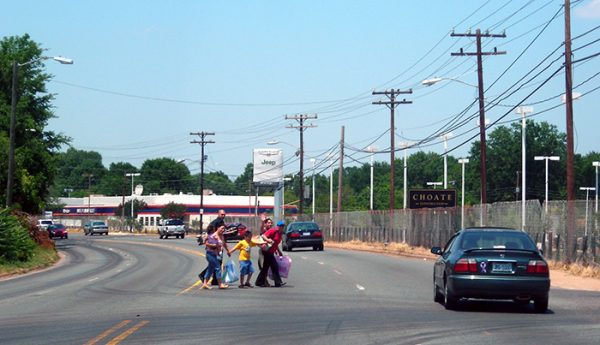City’s Charlotte WALKS initiative aims to improve walkability

Since the late 1990s, Charlotte has experienced a major policy shift toward creating more walkable streets. The evidence is seen in infrastructure investments that are making Charlotte a better place to walk. Yet the city still faces significant challenges: a legacy of our decades of auto-oriented development.
On Monday, I gave a presentation to the Transportation and Planning Committee of Charlotte’s City Council introducing the “Charlotte WALKS” strategy. The effort is intended to acknowledge the challenges we continue to face and offer a path forward for improving walkability.
Acknowledging the challenge
Read more |
In 2014, Charlotte received an unfortunate trio of acknowledgments. We were ranked the “10th most dangerous metropolitan area in the country for pedestrians” (Dangerous by Design from the National Complete Streets Coalition and Smart Growth America), the “fifth most sprawling large metropolitan area in the country” (Measuring Sprawl 2014, from Smart Growth America), and, from Walk Score, the “least walkable big city (population 250,000 or more) in America” (WalkScore.com).
There are plenty of reasons why these statistics are a bit misleading. For example, the first two statistics have as much to do with other municipalities in our region as with Charlotte. And the “least walkable big city” statistic doesn’t take into account Charlotte’s enormous land area compared to other big cities on their ranking list. (Charlotte is roughly three to six times larger in acreage than many cities at the top of Walk Score’s list, which makes the list a bit of an apples-to-oranges comparison. If you compared the most walkable third of Charlotte to those cities, we’d fare better.)
That said, rather than making excuses and poking holes in these studies’, I think it’s a lot more useful to accept the criticism and acknowledge the consensus of these independent groups: We’ve got a lot of work to do on walkability.
Why Charlotte struggles with walkability
Charlotte is a Sun Belt city, and like nearly all Sun Belt cities, we suffer from a legacy of auto-oriented development. For almost half a century following World War II, Charlotte had a transportation policy focused almost entirely on accommodating the automobile. It was all about moving as many cars as quickly as possible. These auto-oriented policies were in place as Charlotte experienced the greatest growth, in population and area, in city history. From 1950 to 2000, Charlotte’s population doubled, then doubled again. Even more significant, the city’s boundaries expanded by nearly 220 square miles to today’s roughly 300 square miles. (To compare, that 220 square-mile-expansion is like adding four times the area of present-day Boston.)
The combination of the auto-oriented policies and that huge growth left a legacy of streets and neighborhoods designed primarily, if not exclusively, for vehicles and created an overall lack of pedestrian mobility. We’re a challenging place for pedestrians because Charlotte, like many other cities, forgot about walkability.
Charlotte WALKS
The good news is that the mission of the Charlotte Department of Transportation today is aligned with the issues noted in those 2014 headlines. There is an appropriate sense of urgency in Charlotte about walkability. Elected officials, civic leaders and, most important, the residents we serve believe walkability is fundamental to Charlotte’s long-term success.
This is not just a transportation issue. It’s a public health issue. It’s an environmental issue. It’s an economic development issue. It’s an equity issue. Every address in the city should be accessible by foot.
For the past two decades, this has been a major policy focus of the City, and we’ve seen some big improvements. The intent of the “Charlotte WALKS” initiative is to build on the city’s recent emphasis on walkability and create more places in Charlotte that offer an excellent pedestrian experience.
We’ll use three criteria to judge success:
- Does the pedestrian experience offer a variety of useful destinations?
- Do our streets and greenways provide a safe pedestrian experience for all different kinds of users?
- Is the pedestrian experience pleasant, comfortable and inviting?
Over the past several months, I’ve talked with dozens of people looking for those same three things: a more useful, safe and inviting pedestrian experience in Charlotte.
- Senior citizens who equate walkability with independence.
- Millennials who aspire to a walkable lifestyle as a status symbol, similar to the way earlier generations aspired to a big, shiny car in the driveway.
- Residents who walk because that’s their only option.
- Civic leaders who believe a more walkable Charlotte is a better Charlotte for everyone.
- A young mother tirelessly advocating for a safer pedestrian environment for her children and neighbors.
- A visually impaired woman whose walking experience is a daily challenge.
These are some of the stories that lie behind the “Charlotte WALKS” strategy. Now we’d like to hear your story.
One initial step in “Charlotte WALKS” is to invite Charlotteans to describe what a great pedestrian experience looks like in Charlotte. So please reach out to me (spcurry@charlottenc.gov) to let us know:
- Where are your favorite places to walk and why?
- What does a useful, safe and inviting pedestrian experience look like for you and your family?
- What kinds of things can the city do to create better pedestrian experiences in Charlotte?
Over the next year, we will use your stories as we move forward on the “Charlotte WALKS” strategy. Ultimately, those stories will be an important part of our effort to coordinate the city’s various walkability initiatives and provide some specific recommendations for ways we can make Charlotte a more walkable place for everyone.
Scott Curry is an urban designer for the City of Charlotte Department of Transportation. He manages the city’s pedestrian program.
Opinions in commentary articles are those of the author and not necessarily those of the UNC Charlotte Urban Institute or the University of North Carolina at Charlotte.